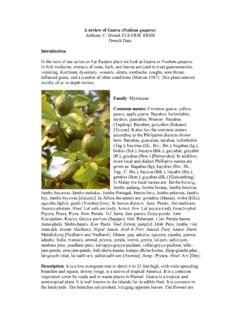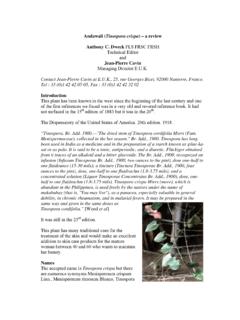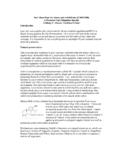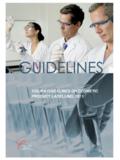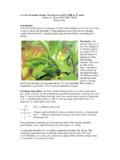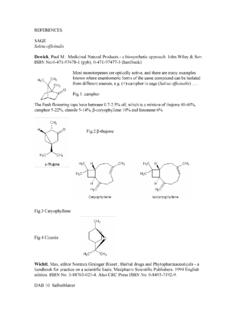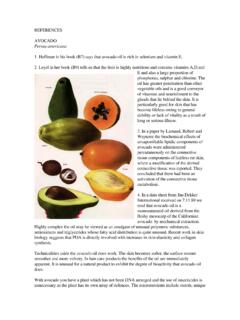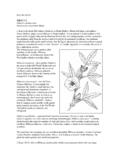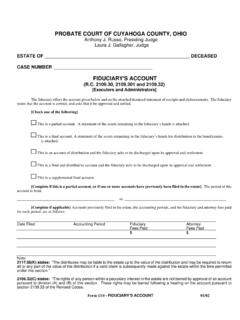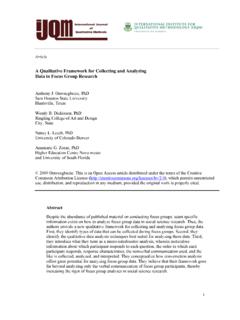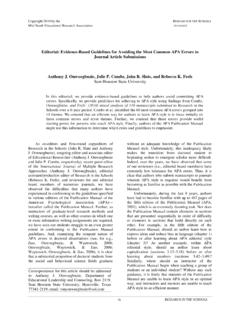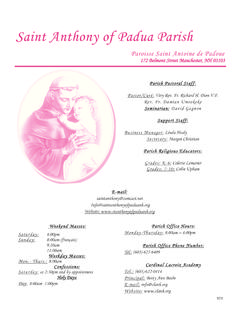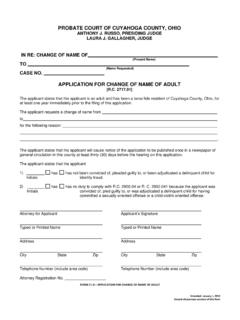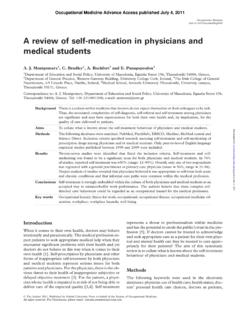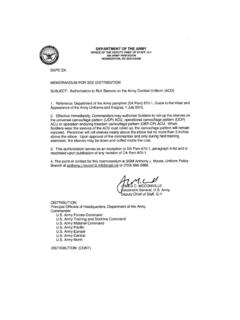Transcription of Alert - Anthony Dweck
1 Alert Sodium Laureth Sulfate and SLS Information circulating around the Internet has raised questions about the safety of Sodium Laureth Sulfate. The Cosmetic Ingredient Review (CIR) has fully assessed the safety of this ingredient and found it to be safe. CIR is an independent organization established to thoroughly review and assess the safety of ingredients used in cosmetics in an open, unbiased and expert manner, and to publish the results in the open scientific literature. CIR has established a seven-member Expert Panel comprised of individuals expert in dermatology, pharmacology, chemistry, and toxicology - these independant scientists and physicians perform the reviews.
2 This information that is circulating also has used SLS as a synonym for Sodium Laureth Sulfate. This is incorrect as well. SLS actually stands for Sodium Lauryl Sulfate, which a different chemical. The following information is provided from the Cosmetic Ingredient Review safety assessments of both Sodium Laureth Sulfate and SLS (Sodium Lauryl Sulfate). Sodium Laureth Sulfate and Ammonium Laureth Sulfate Published in the Journal of the American College of Toxicology, Volume 2, Number 5, pp. 1-34, 1983. Discussion Sodium Laureth Sulfate and Ammonium Laureth Sulfate are cosmetic detergents that exert emulsifying action, thereby removing oil and soil from the hair and skin.
3 The Panel wishes to point out that these two ingredients produce eye and/or skin irritation in experimental animals and in some human test subjects; irritation may occur in some users of cosmetic formulations containing the ingredients under consideration. The irritant effects are similar to those produced by other detergents, and the severity of the irritation appears to increase directly with concentration. However, Sodium and Ammonium Laureth Sulfate have not evoked adverse responses in any other toxicologic testing. Conclusion It is recognized that Sodium and Ammonium Laureth Sulfate may induce eye and skin irritation.
4 However, on the basis of the available information, the Panel concludes that Sodium Laureth Sulfate and Ammonium Laureth Sulfate are safe as presently used in cosmetic products. Sodium Lauryl Sulfate (SLS) and Ammonium Lauryl Sulfate Published in the Journal of the American College of Toxicology, Volume 2, Number 7, pp. 127-181, 1983. Discussion Sodium Lauryl Sulfate and Ammonium Lauryl Sulfate are irritants in patch testing at concentrations of 2 percent and greater, and that irritation increases with ingredient concentration. In some cosmetic formulations, however, that irritant property is attenuated.
5 The longer these ingredients stay in contact with the skin, the greater the likelihood of irritation, which may or may not be evident to the user. Although Sodium Lauryl Sulfate is not carcinogenic in experimental animals, it has been shown that it causes severe epidermal changes to the area of the skin of mice to which it was applied. This study indicates a need for tumor-enhancing activity assays. Autoradiographic studies of rat skin treated with radiolabelled Sodium Lauryl Sulfate found heavy deposition of the detergent on the skin surface and in the hair follicles; damage to the hair follicle could result from such deposition.
6 Further, it has been reported that 1 percent and 5 percent Sodium Lauryl Sulfate produced significant number of comedones when applied to the pinna of albino rabbits. These two problems - possible hair loss and comedone formation - along with proven irritancy, should be considered in the formulation of cosmetic products. Sodium Lauryl Sulfate and Ammonium Lauryl Sulfate appear to pose less potential hazard when in products designed for brief, discontinuous use, following which they are thoroughly rinsed from the surface of the skin. Conclusion Sodium Lauryl Sulfate and Ammonium Lauryl Sulfate appear to be safe in formulations designed for discontinuous, brief use followed by thorough rinsing from the surface of the skin.
7 In products intended for prolonged contact with skin, concentrations should not exceed 1 percent. The Gower data base. Jan. 1995 Sodium lauryl sulfate (INCI)GEN-89 Sodium lauryl sulfate (INCI) CAS 151-21-3; 68585-47-7; 68955-19-1; EINECS 205-788-1 Synonyms: SDS; Sulfuric acid, monododecyl ester, sodium salt; Sodium dodecyl sulfate Definition: Sodium salt of lauryl sulfate Empirical: C12H26O4 SNa Formula: CH3(CH2)10CH2 OSO3Na Properties: White to cream crystals, flakes, or powd., faint odor; sol. in water; Toxicology: Poison by intravenous, intraperitoneal routes; moderately toxic by ingestion; human skin irritant Uses: Anionic detergent; surface tension depressant; emulsifier for fats; wetting agent; in textile industry, in toothpastes Use level: limitation 10 ppm (vegetable oils, animal fats) Regulatory: FDA 21 CFR Trade names: Akyporox SAL SAS; Zoharpon LAS Spray Dried Trade names containing: Amisol 638; Miracare 2 MCA-SF; Miracare 2 MCA; Miracare 2 MCAS; Miracare M1.
8 Zoharteric Merck Index 12 edition Sodium Lauryl Sulfate. Sulfuric acid monododecyl ester sodium salt; sodium dodecyl sulfate; SDS; Irium. C12H25 NaO4S; mol wt C , H , Na , O , S CH3(CH2)10CH2 OSO3Na. Anionic detergent prepd by sulfation of lauryl alcohol, followed by neutralization with sodium carbonate: A. Lottermoser, F. Stoll, Kolloid-Z. 63, 50 (1933). Surfactant properties: J. Powney, C. C. Addison, Trans. Faraday Soc. 33, 1244 (1937); E. E. Dreger et al., Ind. Eng. Chem. 36, 610 (1944). Use in electrophoretic sepn and mol wt estimation of proteins: A.
9 L. Shapiro et al., Biochem. Biophys. Res. Commun. 28, 815 (1967); K. Weber, M. Osborn, J. Biol. Chem. 244, 4406 (1969); of glycopolypeptides: B. S. Leach et al., Biochemistry 19, 5734 (1980). Toxicity study: A. I. T. Walker et al., Food Cosmet. Toxicol. 5, 763 (1967). Review of toxicology: Ch. Gloxhuber, Arch. Toxicol. 32, 245-270 (1974). White or cream-colored crystals, flakes, or powder. Faint odor of fatty substances. Smooth feel. Neutral reaction. One gram dissolves in 10 ml water, giving an opalescent soln. Lowers the surface tension of aq solns.
10 Emulsifies fats. LD50 orally in rats: 1288 mg/kg (Walker). USE: Wetting agent, detergent, esp in the textile industry. Electrophoretic separation of proteins and lipids. Ingredient of toothpastes. SODIUM LAURYL SULFATE Chemical Abstract Service (CAS) Number: 151-21-3 GeneralSodium lauryl sulfate (SLS) is an anionic surfactant. By lowering the surface tension of aqueous solutions, surfactants can act as wetting agents by enhancing the spread of water over National Industrial Chemicals Notification and Assessment Scheme (NICNAS) has received a large number of enquiries regarding concern over data on the internet claiming SLS is hazardous to human health.
